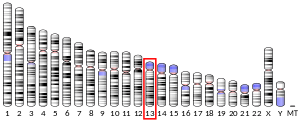FGF14
Fibroblast growth factor 14 is a protein that in humans is encoded by the FGF14 gene.[5][6][7]
The protein encoded by this gene is a member of the fibroblast growth factor (FGF) family. FGF family members possess broad mitogenic and cell survival activities and are involved in a variety of biological processes, including embryonic development, cell growth, morphogenesis, tissue repair, tumor growth and invasion. A mutation in this gene is associated with autosomal dominant cerebral ataxia. Alternatively spliced transcript variants have been found for this gene.[7]
References
- 1 2 3 GRCh38: Ensembl release 89: ENSG00000102466 - Ensembl, May 2017
- 1 2 3 GRCm38: Ensembl release 89: ENSMUSG00000025551 - Ensembl, May 2017
- ↑ "Human PubMed Reference:".
- ↑ "Mouse PubMed Reference:".
- ↑ Smallwood PM, Munoz-Sanjuan I, Tong P, Macke JP, Hendry SH, Gilbert DJ, Copeland NG, Jenkins NA, Nathans J (Oct 1996). "Fibroblast growth factor (FGF) homologous factors: new members of the FGF family implicated in nervous system development". Proc Natl Acad Sci U S A. 93 (18): 9850–7. doi:10.1073/pnas.93.18.9850. PMC 38518. PMID 8790420.
- ↑ Wozniak DF, Xiao M, Xu L, Yamada KA, Ornitz DM (Mar 2007). "Impaired spatial learning and defective theta burst induced LTP in mice lacking fibroblast growth factor 14". Neurobiol Dis. 26 (1): 14–26. doi:10.1016/j.nbd.2006.11.014. PMC 2267915. PMID 17236779.
- 1 2 "Entrez Gene: FGF14 fibroblast growth factor 14".
Further reading
- Wang Q, Bardgett ME, Wong M, et al. (2002). "Ataxia and paroxysmal dyskinesia in mice lacking axonally transported FGF14". Neuron. 35 (1): 25–38. doi:10.1016/S0896-6273(02)00744-4. PMID 12123606.
- Chumakov I, Blumenfeld M, Guerassimenko O, et al. (2002). "Genetic and physiological data implicating the new human gene G72 and the gene for d-amino acid oxidase in schizophrenia". Proc. Natl. Acad. Sci. U.S.A. 99 (21): 13675–80. doi:10.1073/pnas.182412499. PMC 129739. PMID 12364586.
- Strausberg RL, Feingold EA, Grouse LH, et al. (2003). "Generation and initial analysis of more than 15,000 full-length human and mouse cDNA sequences". Proc. Natl. Acad. Sci. U.S.A. 99 (26): 16899–903. doi:10.1073/pnas.242603899. PMC 139241. PMID 12477932.
- van Swieten JC, Brusse E, de Graaf BM, et al. (2003). "A Mutation in the Fibroblast Growth Factor 14 Gene Is Associated with Autosomal Dominant Cerebral Ataxia". Am. J. Hum. Genet. 72 (1): 191–9. doi:10.1086/345488. PMC 378625. PMID 12489043.
- Dunham A, Matthews LH, Burton J, et al. (2004). "The DNA sequence and analysis of human chromosome 13". Nature. 428 (6982): 522–8. doi:10.1038/nature02379. PMC 2665288. PMID 15057823.
- Popovici C, Conchonaud F, Birnbaum D, Roubin R (2004). "Functional phylogeny relates LET-756 to fibroblast growth factor 9". J. Biol. Chem. 279 (38): 40146–52. doi:10.1074/jbc.M405795200. PMID 15199049.
- Stevanin G, Durr A, Dussert C, et al. (2005). "Mutations in the FGF14 gene are not a major cause of spinocerebellar ataxia in Caucasians". Neurology. 63 (5): 936. doi:10.1212/01.wnl.0000137020.30604.1e. PMID 15365159.
- Dalski A, Atici J, Kreuz FR, et al. (2005). "Mutation analysis in the fibroblast growth factor 14 gene: frameshift mutation and polymorphisms in patients with inherited ataxias". Eur. J. Hum. Genet. 13 (1): 118–20. doi:10.1038/sj.ejhg.5201286. PMID 15470364.
- Lou JY, Laezza F, Gerber BR, et al. (2006). "Fibroblast growth factor 14 is an intracellular modulator of voltage-gated sodium channels". J. Physiol. 569 (Pt 1): 179–93. doi:10.1113/jphysiol.2005.097220. PMC 1464207. PMID 16166153.
- Brusse E, de Koning I, Maat-Kievit A, et al. (2006). "Spinocerebellar ataxia associated with a mutation in the fibroblast growth factor 14 gene (SCA27): A new phenotype". Mov. Disord. 21 (3): 396–401. doi:10.1002/mds.20708. PMID 16211615.
- Zhao Y, Lim SW, Tan EK (2007). "Genetic analysis of SCA 27 in ataxia and childhood onset postural tremor". Am. J. Med. Genet. B Neuropsychiatr. Genet. 144 (3): 395–6. doi:10.1002/ajmg.b.30472. PMID 17221845.
This article is issued from
Wikipedia.
The text is licensed under Creative Commons - Attribution - Sharealike.
Additional terms may apply for the media files.



